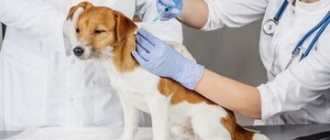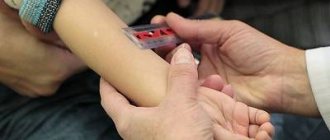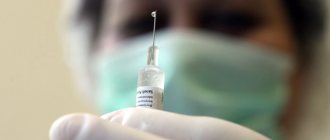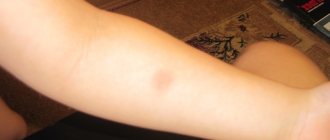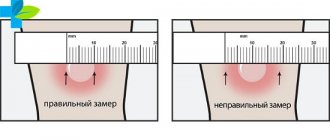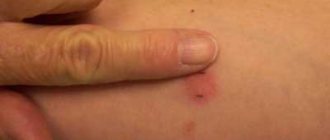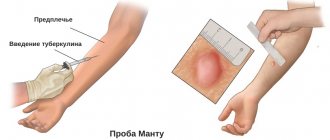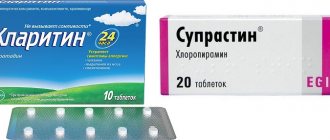The child is allergic. To vaccinate or not to vaccinate. 6 misconceptions of parents.
March 13, 2017
Vaccination is the creation of artificial immunity to certain diseases. Currently, this is one of the leading methods of preventing infectious diseases.
Infections against which vaccines exist are called manageable or controllable, and their incidence rate largely depends on the number of vaccinated people in the entire population. It is known that to achieve epidemic prosperity in the country, at least 95% of the population must be vaccinated. This means that not only healthy people are subject to vaccination, but also people suffering from various diseases, including allergies.
At the same time, every year there is a significant increase in allergic diseases throughout the world. International statistics show that over the past two decades the incidence of allergic pathology has increased 3-4 times. Every fifth person on our planet suffers from allergies. Allergic rhinitis, conjunctivitis occurs in 4-20% of the population. Bronchial asthma affects 5-15% of the entire world population. Atopic dermatitis accounts for 20-30% of all allergic diseases in children. Every second person in the world has suffered an episode of urticaria at least once in their life.
Conversations about the necessity and dangers of vaccinations flare up and then die out among parents of allergy sufferers. There are voices calling for a complete abandonment of broad immunoprophylaxis in order to “preserve the health of children.” To dispel the doubts and misconceptions of parents of children suffering from allergies, this article has been prepared.
Misconception No. 1
Preventive vaccinations are contraindicated for persons suffering from allergic diseases. Children and adults with allergic diseases should receive preventive vaccinations against all infections included in the National Schedule of Preventive Vaccinations. However, vaccination of these patients is carried out in compliance with certain rules. Vaccination of persons with allergic diseases is carried out upon achieving complete or partial remission, upon achieving control of the course of allergic pathology, including against the background of basic therapy. Such patients should be more carefully examined and examined before vaccination, and observed after vaccination. Very often, preventive vaccinations for patients with allergic diseases are carried out under the “cover” of antihistamines, which minimizes the risk of adverse reactions in such patients. Management tactics are based on an individual approach to each patient. Patients with a burdened allergic anamnesis, together with the local pediatrician, must be consulted by an allergist-immunologist; if necessary, correction of the basic and symptomatic therapy of the allergic disease is carried out; a decision is made on the timing of vaccination, the volume of medication preparation and the choice of vaccine drug. For example, patients with hay fever (seasonal allergic rhinitis and conjunctivitis) are vaccinated outside the dusting season of trees and grasses, patients suffering from drug allergies are prescribed preventive vaccinations after a short course of antihistamines, patients with manifestations of food allergies are vaccinated against the background of a strict hypoallergenic diet .
Misconception #2
Vaccines used for immunoprophylaxis “allergize” the human body.
Modern vaccines, both live and inactivated, promote the body's production of protective anti-infective antibodies - immunoglobulins of classes G and M; at the same time, they practically do not increase the level of total immunoglobulin E and the production of specific IgE antibodies involved in the formation of allergopathology.
Misconception #3
Adverse reactions that develop after preventive vaccination are a contraindication to further vaccination.
Post-vaccination reactions and post-vaccination complications should be distinguished. Post-vaccination reactions include increased body temperature and the appearance of lumps of various sizes at the injection site. Such phenomena are not contraindications for further vaccination, but should be taken into account by the doctor to determine further immunoprophylaxis tactics. So, for example, if post-injection thickening of the gluteal region occurs, the next vaccination should be performed in the area of the outer surface of the thigh or the upper third of the shoulder.
Post-vaccination allergic complications in the form of a generalized allergic reaction or anaphylactic shock are absolute contraindications for vaccination with the same vaccine or a vaccine containing a causative component. So, for example, if edema and urticaria develop after administration of AS toxoid, the use of DPT vaccine and ADSM toxoid is contraindicated. Carrying out preventive vaccinations against hepatitis B and influenza in this case has no contraindications.
It should be remembered that patients who are allergic to chicken egg whites are a contraindication for vaccination with influenza, measles, and mumps vaccines, since these vaccines are prepared on a chicken substrate. These vaccines also contain traces of aminoglycoside antibiotics, which is important to consider as a contraindication for patients who have systemic allergic reactions to antibiotics.
Misconception #4
For patients suffering from allergic rhinitis and bronchial asthma, flu vaccinations are contraindicated, as they aggravate the course of the underlying disease.
Patients with chronic diseases of the respiratory system are at risk of adverse consequences from acute respiratory viral infections and influenza. In children and adults with allergic diseases of the respiratory system, it is advisable to expand the schedule of preventive vaccinations by vaccination against pneumococcal infection and annual vaccination against influenza. Vaccination against these infections reduces the incidence of influenza and pneumonia, the frequency and severity of exacerbations of the underlying disease, which makes it possible to lengthen the period of remission of chronic bronchopulmonary pathology and achieve a reduction in the volume of basic therapy.
Misconception #5
The use of combined vaccines for people suffering from allergic diseases is not advisable, since multicomponent vaccines are more likely to cause unwanted reactions.
Most inactivated vaccines contain additional substances - adsorbents (adjuvants) and preservatives (stabilizers). They are often the cause of local reactions in the form of swelling and hyperemia of the skin. Therefore, the use of combined vaccines makes it possible to reduce the total volume of administered preservatives, which reduces the number of post-vaccination reactions. For example, the use of the Pentaxim vaccine allows for vaccination against whooping cough, diphtheria, tetanus, polio and hemophilus influenzae and replaces the administration of several injections of vaccine preparations.
Misconception #6
If a child has allergies, the Mantoux test should not be done, because... it will not be informative.
First of all, it is worth saying that the Mantoux test is not a vaccination, i.e. it does not protect the body from tuberculosis, but tests for its presence. The thing is that tuberculosis is often asymptomatic, affecting not only the lungs, but also other organs and systems, and even some parts of the brain; more often this happens when the body’s defenses are reduced.
What will be a decrease in immunity for atopic children? Of course, any exacerbation of the disease weakens the body, which is the reason for the start of the infectious process. That is why experts recommend performing all Mantoux tests in a timely manner, the results of which allow timely diagnosis of possible risks of a serious disease.
The substance “Tuberculin” itself is an allergen for the human body, therefore, an allergic reaction in the form of redness is often observed at the injection site, so it is often regarded as a false-positive test result, so additional examination may be required.
Is it possible to make mantu from vaccinations?
Medical diversion from Mantoux can be complete or temporary. In the first case, parents will be offered other methods for diagnosing tuberculosis; in the second, they will only need to wait for the child to recover.
Most often, a medical drain is placed for 3-4 weeks, sometimes this period increases to 2-6 months, in extreme cases it is extended further. It is important to achieve a complete recovery of the child and restoration of his body - this will make it possible to avoid complications after the Mantoux test and obtain the most reliable result.
What is a medical outlet from Mantoux
Medical withdrawal is a temporary or complete refusal to perform the Mantoux test; such a decision is made only by the pediatrician based on the results of the examination of the child. The independent decision of parents to refuse such a diagnosis of tuberculosis is not a medical decision.
Watch the video on how to refuse the Mantoux test:
The Mantoux test itself does not lead to disease, but in some cases it is better to exclude the administration of tuberculin, because the results can be false positive, and the risk of complications under certain conditions becomes high.
What is a medical guide to the Mantoux test?
A medical withdrawal is a temporary or complete refusal of a tuberculin test for medical reasons. Only a doctor can decide whether to give a medical exemption to a child based on the results of a preliminary examination and the results of the examination. Parents' reluctance to conduct diagnostics for personal reasons does not mean that the pediatrician will issue a medical exemption.
Determining the reaction to tuberculin is a method of checking the presence of specific immunity to mycobacteria, which are the causative agent of the disease. This protective mechanism must be formed as a result of undergoing a cycle of BCG vaccinations. The Mantoux allergy test allows you to assess not just the presence of such immunity, but also the degree of its tension. In a patient with tuberculosis, the immune system is active, since at the time of administration of tuberculin serum the body is already fighting the causative agent of the disease.
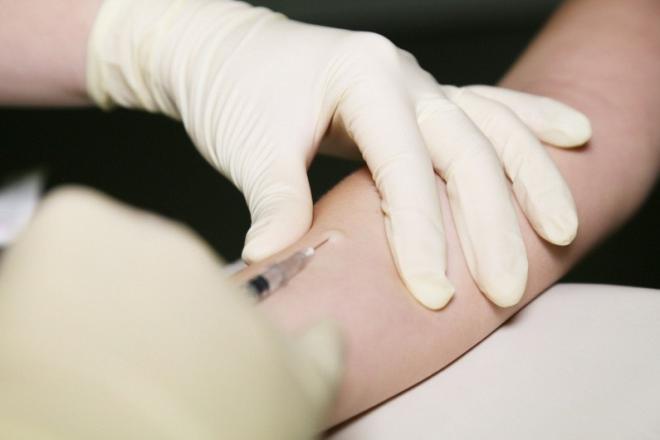
The results are assessed no earlier than 72 hours after the administration of the tuberculin composition. You should not interpret the reaction yourself; only a medical professional will do this correctly. If the child has been vaccinated with BCG, the diameter of the papule is considered normal from 5 to 12-16 mm. Different sources (even official ones) indicate different meanings.
In itself, testing for Koch's bacillus does not pose any danger, provided that the child is completely healthy, since the diagnostic drug does not contain live bacteria. But in certain situations, withdrawal is a truly reasonable decision, since an allergy test performed during an illness not only gives incorrect results, but can also lead to serious complications.
Full
Depending on the reasons why the doctor gives Mantoux a medical diversion, it can be complete or temporary. A complete withdrawal is justified if the child has a certain condition or disease in which the administration of tuberculin is guaranteed to cause serious complications. The pediatrician issues such a waiver forever.
Temporary
The doctor gives a temporary delay in carrying out the test for no more than six months if the patient has an infectious or non-infectious disease or an exacerbation of a chronic disease. In cases with a diagnosis of acute respiratory infections or acute intestinal disease, the injection is given immediately after the temperature and stool normalize. Most often, a partial allotment is issued for no more than two months. If, after the maximum period (six months), the doctor cannot give an opinion on the possibility of administering tuberculin, the medical withdrawal is extended.
Consequences of introducing tuberculin into a weakened body
Mantoux diagnostics are carried out to identify infectious lesions of the body with Koch bacilli (this bacterium is the cause of tuberculosis). This method is recognized as one of the most informative. However, the consequences of introducing tuberculin into an organism weakened by any infection can be unpredictable and sometimes disastrous.
If tuberculin diagnostics are carried out with violations of the time frame, the following symptoms may appear:
- runny nose and cough;
- weakness, chronic fatigue;
- problems with the gastrointestinal tract: constipation or diarrhea;
- a child may develop a severe allergy to Mantoux: intense irritation not only at the injection site, but also the spread of hives throughout the body;
- nausea, vomiting;
- dizziness;
- cephalgia.
Some pediatricians do not follow the injection schedule after illnesses due to their incompetence; in addition, parents are largely responsible for the consequences. They have every right to refuse a tuberculin test in writing and demand a medical exemption (a document officially prohibiting injection tests and all types of vaccinations against other diseases for a certain period), even if the pediatrician urges them to administer Mantoux as soon as possible.
Temporary medical diversion from Mantoux after illness
Medical withdrawal from Mantoux after an illness is given temporarily, and usually it does not exceed a period of 6 months. In practice, even after suffering acute infectious diseases and exacerbations of chronic pathologies, the doctor can postpone the timing of medical manipulation by 2 months.
If, after the specified period, the pediatrician does not give permission to test the mantu, then the medical withdrawal will be extended, and it will still be considered temporary.
How many days do they give after ARVI, chickenpox?
After an acute respiratory viral infection, the doctor does not allow tuberculin diagnostics to be carried out until the child’s body temperature normalizes and all symptoms of the disease disappear. In cases of uncomplicated ARVI, complete recovery usually occurs within 7-10 days, but the doctor will give the child’s body time to recover - about another 1-2 weeks. Thus, the total time for medical withdrawal due to ARVI will be 4 weeks.
As for chickenpox, medical withdrawal will be at least 35 days, more often it is extended to 2 months.
Complications after
If the Mantoux test is performed without taking into account the state of the body in connection with the ongoing disease, then the following complications are possible:
- an increase in body temperature, the development of symptoms of pathology with “new strength” - is associated with a sharp weakening of the immune system;
- obtaining false positive results - this leads to unnecessary examination, registration of the child with a TB specialist, and additional diagnostic procedures;
- obtaining a false negative result - the time for identifying Koch's bacillus in the body and starting therapy against tuberculosis may be missed;
- development of a severe allergic reaction.
What is a medical outlet

A medical withdrawal is a complete or temporary refusal to undergo vaccination or the Mantoux test. The doctor decides which Mantoux medications to give to a particular child after an examination.
This test in itself is not dangerous if the child is absolutely healthy. Previously identified somatic diseases are not a contraindication to the procedure. In order for the result of the tuberculin test to be reliable and the child does not experience complications associated with its conduct, the physician must assess the patient’s health status and check with contraindications.
The reasons why a doctor may give a medical exemption are as follows:
- Increased body temperature. In this case, Mantoux can be performed only 4 weeks after the temperature has normalized.
- Having a cough. Even if the cause is not related to a cold, it may be a consequence of allergies or bronchial asthma. In this case, the procedure is postponed until the exact cause of the cough is determined.
- Having a runny nose. The doctor can send the child for Mantoux a month after recovery.
- Acute period of any disease. The doctor decides how long you need to wait before the test is performed. Usually this can be done only after complete recovery and bacteriological analysis.
- Skin diseases that occurred immediately before the procedure. It can be done after complete recovery.
- Autoimmune pathologies.
- If any vaccine was administered to the baby within 1-2 months before the expected procedure. In this case, a medical outlet is necessary to ensure that the reaction to the injected drug does not turn out to be false.
- The child has a digestive disorder. The test will be possible only after recovery.
- Chickenpox, respiratory or other viruses.
- Some neurological diseases. In such situations, giving Mantoux to a child is completely prohibited.
- Presence of oncology.
- HIV infection in a child.
Typically, the decision to perform or reschedule a test is made by a pediatrician or immunologist. Can an allergist give a medical treatment for Mantoux? If a child’s allergic reaction has worsened at the moment or after suffering from an acute respiratory viral infection, an allergist can do this.
Also, in such children the procedure for performing Mantoux will be somewhat different. Therefore, it is important to inform the pediatrician and the doctor who will do the test about the presence of any allergies. Usually, such children are recommended to take any antihistamine before performing Mantoux.
Possible complications
The tuberculin test often causes allergic reactions in children. Tuberculin is not a true toxin. It cannot be called an antigen, since antibodies are not formed in the body after injection. It does not contain the tuberculosis bacillus, only its waste products. Despite this, the injection may cause some side effects:
- runny nose;
- nausea;
- vomit;
- headache;
- dizziness;
- appearance of cough;
- skin rashes;
- increased body temperature;
- itching in the injection area.
The most common reaction of the body is considered to be snot after Mantoux. In most cases they go away on their own.
In some situations, due to the impossibility of conducting a test with tuberculin, alternative methods are used. Diaskintest has many positive characteristics. The Quantiferon test and the PCR-based method are used in diagnosis. However, the tuberculin test is so far the only officially recognized method.
Medical diversion from Mantoux: reasons
The reasons for the temporary medical diversion from Mantoux are:
- increase in body temperature, regardless of the reasons - Mantoux is given no earlier than after 30 days;
- runny nose and cough – withdrawal for at least 4 weeks;
- the stage of exacerbation of any chronic disease - before the disease enters the stage of stable remission;
- dermatological diseases - until complete recovery or disappearance of severe symptoms;
- any eating disorders, including diarrhea due to consumption of fruits and berries - until functionality is fully restored (about 3-4 weeks).
Contraindications to Mantoux vaccination in children or reasons for medical withdrawal
Before vaccination, the condition of the patient’s body is always determined. But, unlike other vaccinations, the Mantoux test has relatively few contraindications. This is due to the fact that the administered drug does not contain live pathogens.
Consequently, such microorganisms, having entered the child’s body, cannot cause serious damage to him. But still, in some cases, Mantoux is not recommended. Most often, a medical exemption is given when, due to some factors, the sample may turn out to be false positive or false negative.

The list of contraindications for the Mantoux test is as follows:
- exacerbation of chronic diseases;
- acute respiratory infections and other infectious pathologies (including runny nose);
- manifested allergic reactions;
- epilepsy.
Also, this vaccination cannot be given to children who have not yet reached the age of 1 year. This is due to the fact that the immunity of a small child is not yet well developed.
Therefore, using the Mantoux test it is impossible to judge the body’s reaction to the causative agent of tuberculosis. In most cases, the result is false negative even when the baby’s body is infected. This makes vaccination at an early age a pointless exercise.
Also, manta cannot be given if less than 4 weeks have passed since the last vaccination (with any drug). Otherwise, the test result is almost always false positive. And the last factor is the presence in the group in which the child spends time of a fairly large number of sick children (including those with colds).
Mantu is not allowed to attend kindergarten when quarantine is declared in the group. It does not matter whether the child who needs to be vaccinated is healthy or sick with something.
Complications
A specialist can administer intradermal tuberculin only after checking contraindications. If, if any, a Mantoux diagnosis is performed on a child, there is a high probability of the following complications:
- increased body temperature, often up to forty degrees;
- general malaise, dizziness, severe headaches;
- various disorders of the gastrointestinal tract: nausea, vomiting, loss of appetite, stool disorders;
- dysfunction of the cardiovascular, lymphatic systems and breathing;
- allergic reactions.
In the latter case, uncharacteristic staining and an increase in the size of the papule after Mantoux may be observed. Convulsions and increased sensitivity of the skin may occur. All these symptoms are an indication to immediately seek help from a medical facility.
Many parents confuse medical withdrawal with refusal of Mantoux. The need for the first is determined by the doctor based on the child’s health condition. If parents for any reason do not want the procedure to be carried out, they must write a receipt. It records their decision to abandon Mantoux and to accept responsibility for all the consequences of this step. A written refusal is filed in the child’s medical record. Of course, anti-tuberculosis diagnostics is voluntary (it is mandatory only for persons with an established diagnosis of tuberculosis); according to the law, refusal should not affect the interests of the patient - his rights to education, confidentiality of personal data, and so on.
At the same time, every parent should understand the importance of diagnosing such a common and serious disease. And even if there is a medical contraindication to the test, the child must be checked regularly, but using alternative methods
Is it possible to do Mantoux during medical drainage?
Is it possible to do Mantoux during medical drainage? Of course, it is impossible, or at least undesirable. However, practice shows that the Mantoux reaction is used during medical withdrawal. Naturally, this increases both the likelihood of complications and the likelihood of an incorrect diagnosis. And although no one immediately diagnoses “tuberculosis” based on the results of the Mantoux reaction, you will have to run around the offices. And this is not to mention the complications. And they can be very serious. Among them:
- Deterioration of health, headache, general malaise, increased body temperature;
- Allergic reactions;
- Problems with the gastrointestinal tract - there may be disturbances in appetite, vomiting, as well as diarrhea and other stool disorders
- Cardiovascular pathologies;
Therefore, it is best to listen to doctors who recommend a medical withdrawal from the tuberculin test and either postpone it or replace the Mantoux test with something else.
How to get a medical outlet for Mantoux from an allergist
A medical guide from Mantoux from an allergist can only be obtained personally from a doctor and after a full examination of the child. An allergist will issue a ban on such tuberculin diagnostics if the patient:
- there is a history of allergies to medications;
- Previously, during the test, an inadequate reaction of the body was noted;
- there is a high risk of developing allergies - for example, a child has such a reaction to food, animal hair, plant pollen.
To visit an allergist, you should stock up on some documents from your pediatrician:
- medical record with a specialist’s opinion on the patient’s general health condition;
- a document reporting the timing and results of vaccination(s).
If necessary, the allergist can refer the patient to an immunologist for additional examination.
How to get a medical outlet
Even if a medical exemption from all forms of vaccination has been issued, it does not apply to the analysis of the Mantoux reaction in a child, since the sample is not a vaccination. Only a specialist can determine the presence of contraindications to the procedure, transfer Mantoux or completely prohibit it:
- the pediatrician observing the child issues a certificate in the event of an acute respiratory infection, intestinal disorder, or exacerbation of a chronic disease;
- phthisiatrician – if the patient is registered at an anti-tuberculosis dispensary;
- A medical withdrawal from Mantoux should be obtained from an allergist in case of an allergy to the administered drug or a high probability of its occurrence;
- if the patient is registered with an immunologist, then the medical certificate is issued by this specialist;
- You must contact a neurologist for the document if a neurological disease is diagnosed.
A medical exemption from the Mantoux test can be obtained after an illness. The certificate indicates the period that must pass before the test. The doctor determines the timing and prescribes the injection only after the disease is completely cured.
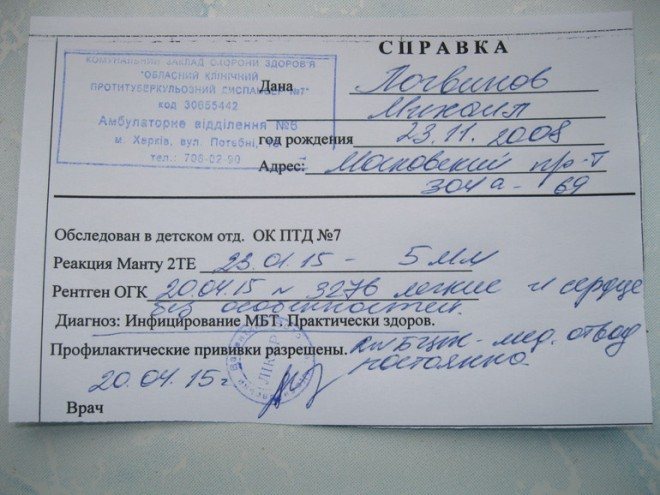
How to replace Manta with complete medical drainage
To diagnose tuberculosis and assess the formation of specific anti-tuberculosis immunity, doctors use not only Mantoux. In medical practice, the following are used: Koch (or Pirquet) tuberculin test, Diaksintest, blood test for ROE, PCR method. These techniques can replace Mantoux in medical withdrawal. All of them are aimed at diagnosing the disease, and they can be used as an additional or primary examination.
Diaskintest, unlike the Mantoux test, reacts not to the immunity formed due to BCG vaccination, but to a specific protein that is secreted by the causative agent of tuberculosis. Thus, a positive reaction will be recorded only in a patient in whose body an intensive process of proliferation of tuberculosis mycobacteria occurs. The procedure for assessing the results of Diaskintest is no different from checking the Mantoux reaction: after three days, the size of the resulting “button” is measured. But only a negative reaction is considered a normal reaction, that is, if the diameter of the papule does not exceed 2 mm. Unfortunately, according to official WHO statistics, while Mantoux gives up to half of false-positive reactions, that is, it shows the possibility of infection in healthy people, Diaskintest, on the contrary, “sins” with a large number of false-negative reactions, that is, it does not detect the disease in actually infected patients.
More accurate results can be obtained by taking an x-ray or using the quantiferon test method. The last alternative option is not only the safest, but also the most accurate, it is indicated even after a recent BCG vaccination. It is better to combine the remaining options to obtain a reliable examination result.
Why is the Mantoux test performed?
The most important thing to remember is that the Mantoux test has nothing to do with vaccinations and vaccinations; it does not contribute to the development of immunity and protection against diseases.
The introduction of tuberculin into a child’s body is considered a diagnostic measure. And depending on whether the body has experience interacting with mycobacterium tuberculosis (Koch's bacillus, tuberculosis bacillus), the reaction to such an injection will be different. When mycobacteria are already present in the body, the diagnostic answer will be positive. In this case, an allergy to tuberculin is observed.
So, we found out that the Mantoux test is an allergy test or diagnostic testing.
When BCG is administered to a newborn, he develops antibodies to Mycobacterium tuberculosis. When antibodies are formed, the Mantoux test is positive. If a child has tuberculosis, the test will be positive.
For the first time, Mantoux is given to a child at the age of one. And after that it is done every year. If there is a negative result, it is performed a second time per year. In a situation where the answer is negative, the question of secondary vaccination (BCG) is raised.
Depending on age, the sample is placed in different hands. Usually, if the age is an even number, then in the right hand, if it is an odd number, in the left.
The location of the test is the middle third of the surface of the forearm from the inside. The test is done subcutaneously.
The Diaskin test is an identical diagnostic test. The test does not react to vaccination, but to Mycobacterium tuberculosis. In healthy people it is negative. The check may consist of an annual fluorography or chest x-ray. They are prescribed if the parents do not agree to the test.
And yet in our country it is customary to perform Mantoux.
Against reason
What threatens all of us if we refuse the Mantoux test? According to the head of the department of phthisiology of the St. Petersburg State Medical University, Doctor of Medical Sciences. Marina Lozovskaya, the introduction of Diaskintest will not allow doctors to identify up to 70% of children at risk.
Irina Mikheeva, head of the immunoprophylaxis laboratory of the Central Research Institute of Epidemiology of Rospotrebnadzor, estimated that when switching to DST, more than 300 cases of active tuberculosis in children every year may go undetected. The patient will infect family members and other children. And for the sickest child, a serious illness will take away his childhood and can ruin his whole life.
“By making a too quick decision to replace (the Mantoux test with DST. - Ed.), we may simply lose our well-functioning tuberculin diagnostic system and the idea of how many infected children we have,” says Professor Lozovskaya. “But our prevention system was built on identifying not only sick children, but also infected ones, and, if necessary, starting preventive treatment.”
But why is DST, with all its shortcomings, recommended for widespread use? According to the estimates of the main pediatric phthisiatrician of Russia and the main adherent of DST, Valentina Aksenova, who, by the way, took part in the creation of this drug as part of a group of researchers commissioned by , “DST will allow us to take the diagnosis of tuberculosis to a new level, avoid unnecessary treatment and fully identify risk groups for tuberculosis and local forms in the early stages.” If this were true, one could even accept the fact that DST is more expensive than the Mantoux test.
However, the health of children and the safety of the entire society for some reason are not the main criterion for making such important decisions. Naturally, the question arises: why are decisions concerning public money, and considerable ones at that, made without preliminary serious analysis and expert assessments? According to media reports, the state will be forced to spend at least 2.1 billion budget rubles per year on the purchase of Diaskintest. Nowadays, when the situation with tuberculosis in some regions is very tense, and the costs of its treatment are only growing, the decision to switch to a dubious and incompletely proven diagnostic method may turn out to be erroneous and do more harm than real help to sick children.
How to replace a sample with complete medical drainage
Even if the doctor has given the child a complete medical diversion from Mantoux, it is necessary to diagnose tuberculosis.
For this, doctors offer different methods - Diaskintest, PCR, blood test for ROE. The first option is considered the most informative, accessible and safe - the administered drug reacts not to the immunity of the child’s body, but to a specific protein secreted by the causative agents of the disease. Evaluation of the results of such diagnostics proceeds identically to Mantoux - 72 hours after the procedure, a medical professional measures the papule. Only a result in which the diameter of the “button” does not exceed 2 mm will be negative.
Doctors warn that instead of Mantoux, in order to obtain reliable results, it is better to carry out several examinations at once - for example, combine Diaskintest and a blood test for ROE.
Medical withdrawal from Mantoux can be temporary and complete, but it is given only by a doctor after examining/examining the child. Even with a complete ban on tuberculin diagnostics, manipulations must be carried out - PCR, Diaskintest, and blood tests for ROE are possible. The maximum temporary medical withdrawal lasts 6 months, but it can be extended by a doctor if necessary.
What to replace
Mantoux is not the only method for detecting tuberculosis. You can use Diaskintest instead. This technique is similar to Mantoux, but only with Diaskintest, a drug of the same name is injected subcutaneously - Diaskintest. Tuberculin administered with Mantoux is a natural antigen, and Diaskintest is synthetic. This method is more accurate: the resulting reaction is not interpreted in two ways.
Another way to detect the disease is the Suslov test. When using it, nothing is injected into the human body, but blood is taken from a finger. The biomaterial and tuberculosis pathogens are placed on laboratory glass. Interacting with each other, they form a pattern by which the doctor determines the presence of Koch’s bacillus in the body.
The disadvantage of this method is its low accuracy, no more than 60%.
Unlike a blood test, a genetic test gives a more accurate result. The method of its implementation is based on the polymerase chain reaction, enzyme-linked immunosorbent assay or immunoleukocytosis reaction. If the biomaterial taken from the subject contains at least one molecule of a pathogenic microorganism, this will be reflected in the analysis.
